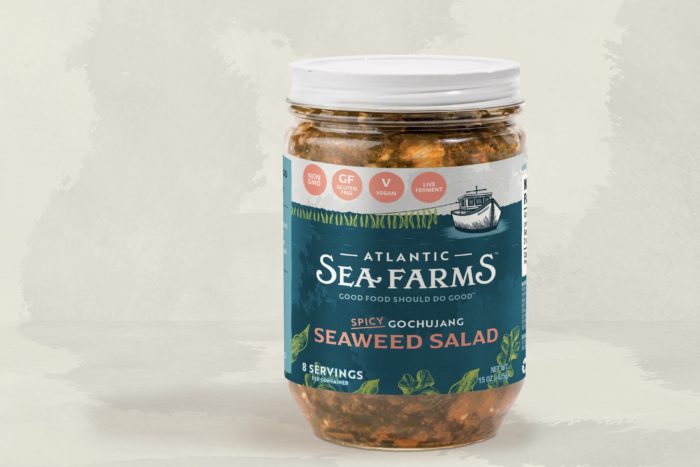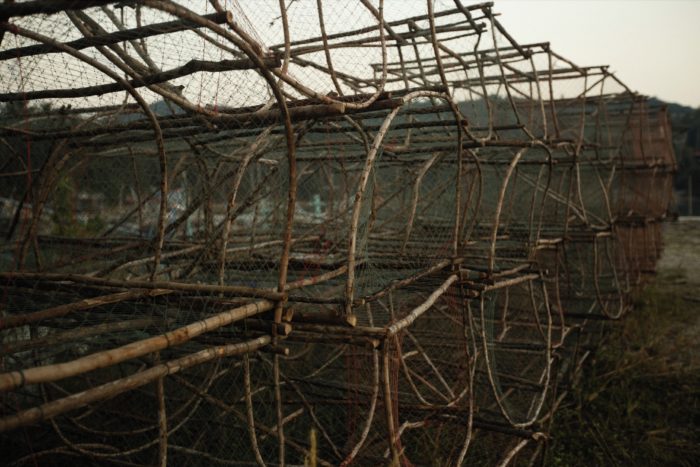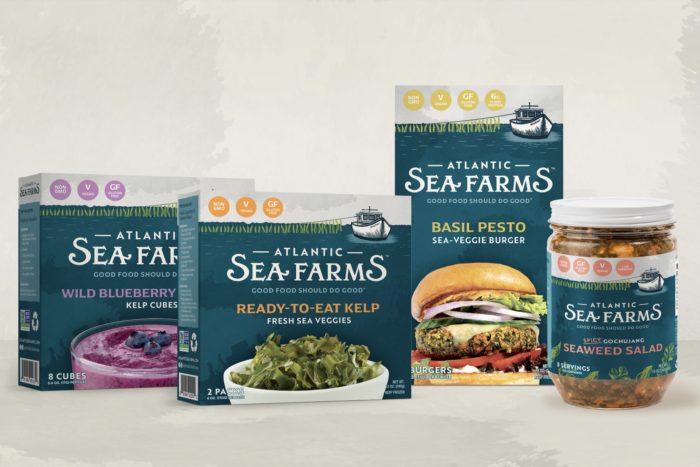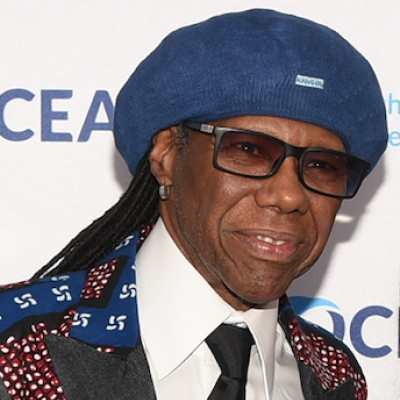
The waters in the Gulf of Maine are warming. This is happening in oceans around the world, but here they’re warming 98% faster, putting the coastal community’s primary source of income—lobstering—at risk. Briana Warner, Maine resident and former U.S. diplomat in the Foreign Service, began working on a solution to help save the sea, slow climate change, and support the community. While working with local fishermen in the off-season, Warner started Atlantic Sea Farms, an aquaculture company that line-grows kelp from mindfully harvested wild kelp seeds. The kelp removes excess carbon and locally mitigates effects of ocean acidification, which helps other sea life thrive. It’s also bursting with vitamins and amino acids, and tastes delicious! Because seaweed farms require no pesticides, arable land or fresh water, it’s one of the cleanest crops out there. As Warner says, “Our food system is one of the largest contributors to global climate change. Our farming system is destroying the planet, making farmers poorer, and consumers less healthy. It is an absolutely broken system and I am incredibly motivated to build an industry that can flip our assumptions about what food can be on its head.” —Jane Ratcliffe
What led you to seaweed farming?
I grew up in Central Pennsylvania in a once thriving community that had fallen by the way of the natural resources it depended on. The experience of seeing the negative economic and social impacts on a community that fails to adapt despite warning signs of impending economic decline has informed my entire career. I started out as a diplomat in the U.S. Foreign Service where I focused on economic development in West Africa. When I moved to Maine, I was lucky enough to start working with Maine’s fishermen to help think about ways to diversify our coastal economy in the face of climate change. The challenge is this: the Gulf of Maine is warming faster than 98% of oceans in the world. Our coastline is almost completely dependent on a lobster monoculture and there are few other fisheries here that can support commercial scale. It became immediately clear to me—and to many others in the state—that we had to figure out other ways to build on our strong and important mariner heritage and make a living on the water.
And, as an optimistic person, I realized that there was something bigger than the challenge: the opportunity. We have more coastline than California. We have clean, cold water that is protected and full of nutrients. We have 4000+ lobster license holders in the state who are individual businesses owners and have the perfect equipment for kelp farming – a counter-seasonal industry. At the same time, 97% of all of the seaweed eaten in the U.S. is imported, not traceable, often grown in compromised waters with questionable labor practices, and is only available in the form of dried snacks, sushi wraps, and bright green rehydrated and dyed seaweed salad.

How does growing seaweed improve the health of the oceans and mitigate the effects of climate change?
Kelp is a zero input crop—it is grown with no arable land, no fresh water, and no pesticides. On top of this, as the ocean gets more acidic because of excess carbon in the atmosphere, kelp can help to locally mitigate some of the effects of climate change by removing carbon and nitrogen from the water column. This “halo effect” under our partner farms can help shell-bearing organisms like mussels, oysters, clams, and even phytoplankton thrive. Kelp is the most climate-friendly food on the planet, and I couldn’t be more proud to get domestic, sustainable kelp grown by fishermen on people’s plates.
Why did you decide to partner with lobstermen?
The Gulf of Maine is warming faster than 98% of oceans in the entire world. This is a devastating statistic, especially given that the majority of our coastal communities are completely dependent on one fishery: lobster. As the water warms, there is increasing evidence that lobster larvae may no longer survive at their current rate and that these communities could be facing an incredibly volatile and uncertain economic future. We have to diversify if we want our coastal communities to continue to thrive and we must look to the ocean—not to the even more volatile and seasonal industry of tourism—to find solutions for this uncertain climate future. Aquaculture (the farming of ocean crops) is one way that we can continue to maintain our incredibly deep and powerful mariner heritage in Maine and the meaningful, rewarding careers that families and communities have relied on for generations. Seaweed aquaculture in particular is well-suited as a supplemental income source for Maine’s fishermen as it is counter seasonal to the lobster fishery; it uses the same equipment and boats that fishermen use for lobstering; and it helps improve the ocean. But don’t take my word for it, you can see what our partner farmers have to say about how they are adapting to a rapidly changing climate in this video.

Also, Maine fishermen may be the best suited in the country to grow kelp. We have 4000+ individual owner-operator lobster license holders with deep knowledge about the ocean and the coastal environment, and the perfect boats for kelp farming. We work with fishermen to help them select their farming locations, provide lease support (yes, you have to lease the water area you farm on), perform regular farm audits, give them free seed, guarantee buy-back of all of the kelp that they grow, provide transportation for all of their crop, process it in our 27,000 sq ft facility, and bring delicious kelp-based products to market. Our customers can be proud that every single bite of our kelp is a step forward to helping create more resilient coastal communities.
Is there a difference between seaweed that grows wild and seaweed that is cultivated?
Each year in early Fall, we collect wild parent material (i.e. seed) for what will become our farmed crop. We dive and search for the best kelp we can find and take very little from the natural environment—about 10lbs for every 400,000lbs we farm. We bring this wild tissue back, use a natural process to have it release its sorus material, and let it naturally bind to twine in our state-of-the-art nursery facility in Biddeford, Maine. We then use natural sea water and lights that mimic daylight to incubate those seeds for 30-45 days at which time its ready to go out onto the farms where they will grow for the next six months. We work with our partner farmers to harvest all of the line-grown kelp between March-June and our kelp can grow up to 2 inches a day at the end of the season. It is identical to the seaweed in the wild and by farming it, we are adding farm systems with significant ecosystem benefits and making the environment and our coastal communities more resilient. It’s a truly regenerative crop.

What impact do seaweed farms have on other inhabitants of the waters such as mussels, oysters, and fish?
Ocean acidification is the result of excess carbon absorbed by the ocean changing the pH of the water. A more acidic ocean creates significant hardship for shell bearing organisms, degrades their shell, and can cause high mortality. By removing carbon and nitrogen from the water column, our kelp makes the ocean less acidic within the halo of the kelp farm and can help mussels, oysters, clams, and even phytoplankton thrive within that halo. Kelp farming is no silver bullet and our positive environmental impact is local, but its effect on an otherwise highly carbon intensive food system is significant.
What are the nutritional benefits of seaweed?
Kelp is a nutrient-dense superfood containing over 60 vitamins and 21 amino acids that satisfy some of our bodies’ essential needs for iodine, calcium, magnesium and a whole host of trace minerals that contribute to thyroid health, heart health, gut health, and blood sugar regulation—all in a low-calorie, high-fiber package.
Seaweed has been a daily integral part of people’s diet in many parts of the world for centuries, particular in Southeast and East Asia where the health benefits are well known. At Atlantic Sea Farms, we work with farmers who grow kelp in the cleanest, state monitored waters to ensure the highest quality products that are nutrient dense and clean. We grow the kelp on the top of the water column and regularly test for any areas of concern.

Do you have a favorite recipe for one of your kelp products?
I put kelp on absolutely everything, if I’m being honest. We have Blueberry Ginger Kelp Cubes that I put in my smoothies in the morning and I eat our Fermented Seaweed Salad, our Sea-Chi (seaweed kimchi) or our Spicy Gochujang Seaweed Salad on the side of almost every dinner. We just released two flavors of our new Sea-Veggie Burger (Basil Pesto and Ginger Sesame) that are absolutely delicious and so easy to eat. My favorite go-to recipe, however, is using our Ready-Cut Kelp, which is shredded blanched frozen kelp, in a clam pasta. It adds a gorgeous color and rich umami flavor that makes the dish stand out.
We have our own branded products available across the country, but our kelp is also included as an ingredient in other people’s products like green drinks and mixes by Navitas and Thorne as well as in pet foods, cosmetics, and bioplastics. We also work with fast casual chains like True Food Kitchen, restaurants like Blue Hill at Stone Barns, and on college and university campuses.

What does the future hold for Atlantic Sea Farms?
We are working toward a future where we can go to any coastal community in Maine and work with fishermen farming kelp—a place where, by that time, our coastal fishermen will have the opportunities to diversify not only to kelp, but also other native species of seaweed that we are starting to grow. Did you know there are 190 species of seaweed native to Maine and we currently only grow two?! We want to see our kelp in all 16 aisles of the grocery store—not only in our own branded products, but also as an ingredient in other people’s products (I’m looking at you, General Mills, Campbell’s, Unilever, Nestle…). We want to show the world that good food should do good and we can lead the way. I am optimistic for a better future where fishermen can lead the charge on growing the most climate-friendly food on the planet. We are already doing it, but we are just getting started.
Is there anything else you’d like to share?
I think it’s important to note that women occupy only 1% of all executive positions in the global seafood industry. In the U.S., women received less than 2% of all venture funding in 2022 despite the fact that women run 50% of businesses seeking venture funding. I am leading the country’s largest kelp aquaculture company, and that is something that inspires me to keep going every day. I’m excited to show other women and girls that we can defeat all of the odds that are so clearly stacked against us.













